Recreational kayaking is thought to be the fastest growing sport in America. And judging from the number of kayaks aboard cruising boats these days, more and more cruisers are discovering the joys that a kayak … or two … can add to cruising in paradise. This is a reprint of my kayak article which first appeared in Cruising World Magazine, December 2012. Here’s a link if you want to go look at the online article on the Cruising World website.
Step into a kayak and you’ll soon see there is nothing quite like effortlessly gliding through the crystal clear water silently exploring places where you could never get in a dinghy. Dolphins splash, sea turtles swim below and flying fish provide endless entertainment as the kayak drifts by. Beaching your kayak on an uninhabited white sand palm studded beach surrounded by turquoise crystal clear waters is pure magic.
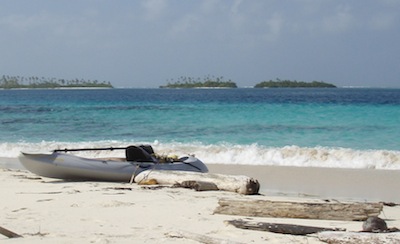
Kayaks provide different things for different people. For me it’s the peace I feel dipping my paddle in the water and the anticipation of the unexpected delights just around the next bend. Starfish wink up from the bottom, eagle rays glide beneath, a startled nurse shark suddenly swims away. Others love the exhilaration of surfing down waves, some just enjoy the quiet scenic beauty. Still others use their kayaks to fish or even dive.
Whatever the rationale, from the inquiries we get from fellow cruisers wanting to buy our kayaks, others clearly wish they’d brought kayaks along cruising. If you’re thinking of adding kayaks to your boat, here are a few tips.
There are several options for different types of kayaks these days, including fantastic plastic, fiberglass, inflatable or even folding kayaks. When we were shopping for our kayaks, we thought inflatable was what we wanted. But when we tested the inflatables, we determined that despite the fact they would stow better, they just didn’t paddle well. Since then, several companies make inflatable kayaks out of hypalon, very rigid and comfortable with inflatable keels and even rudders making the inflatable a possible choice for those that don’t already own the fantastic plastic variety.
Kayak 101
What do you want to do with the kayak? Fishing? Surfing? Quiet paddling among the mangrove channels? Drifting in clear blue water with the manatees? Exploring lush tropical rivers?
Different kayaks are suited for different activities. If you’re serious about surfing or fishing, you may want to consider kayaks specially made for those activities. If you’re like me and just want a kayak that will do everything, a more generic version will be fine. Your best resource will be a high quality kayak store that carries multiple types and brands. There you’ll be able to explore the differences and decide what is best for you.

There are a few basics you should know about kayaks.
Length, width and bottom shape affect speed, maneuverability and stability. Short wide kayaks will be more stable and easier to board from a moving boat. But a shorter kayak will not track as straight with each stroke as a longer narrower kayak. A long thin kayak slices through the water quicker and easier, but is more difficult to turn. A short fat kayak will be much more stable, require a bit more effort to maintain momentum through the water, but turns easily.
Rudder or Not? Most recreational fantastic plastic kayaks are not fitted with rudders. Rudders can be helpful in strong current and wind, allowing you to paddle evenly while your foot pressure controls the rudder adjusting the direction of the kayak. We’ve never wanted one,
Plastic, Fiberglass, or Inflatable? A plastic kayak will be the most durable, but also the heaviest. Fiberglass or inflatable kayaks don’t withstand being drug ashore over rocks and shells nearly as well as plastic. Plastic kayaks are the least expensive so you won’t feel bad putting a scratch or two on the bottom in order to explore paradise! Don’t be afraid of the weight, our 9 foot Wilderness System Riot kayaks weigh approximately 40 pounds and are easily hoisted aboard.
Sit in or Sit On Top? Sit on top kayaks have a few advantages over sit in kayaks, especially for cruisers. Sit on tops have open decks and a lot of paddlers think they’re more comfortable. There’s no risk of being trapped in the kayak if it tips and easier access getting in and out – important when boarding from your boat. Beginning paddlers often feel much more comfortable in a sit on top kayak. They can be easier to use and much less confining – no need to wriggle your legs and torso into a small opening. Sit on tops often require a seat (extra) to be comfortable spending time in the kayak.
Single or Tandem? The choice is entirely up to you, but keep in mind tandem kayaks do not paddle well with just one person.
Paddles and Accessories. Although there are a dizzying array of paddles and accessories available, there are only two that are necessities. First is a paddle. Our paddles are inexpensive and separate into two pieces allowing for easier storage. Make sure you get the right size paddle – with wide kayaks, make sure the paddle is long enough to clear the width. There’s nothing more annoying than a paddle that bangs on the edge of your kayak with every stroke! A rule of thumb is to hold the paddle on top of your head. Bend your elbows 90 degrees and grasp the paddle on both ends. You should still have 4”-6” between your hands and where the blade starts on each end. Since our kayaks are wide, I actually have more like 6-7”. A good kayak store can advise you best.
In our opinion, there’s only one other accessory that is critical if you plan to spend time in your kayak – a seat. Buy the best seat, most comfortable seat you can afford. Sit in different seats on the kayak to decide which is best for you.
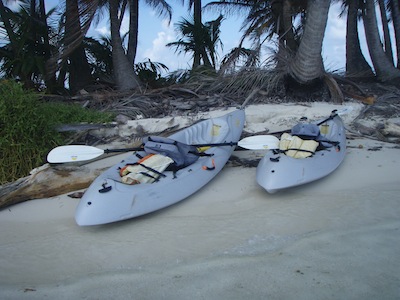
Buying Kayaks
If at all possible, find a kayak store that will let you test the kayak before purchasing – we thought we knew what we wanted and we tested 4 different types –2 different sit ins, a sit on top, and an inflatable. We ended up purchasing a sit on top when we were sure we wanted an inflatable. We have never regretted it. Be sure to test a variety of paddles and maybe even seats at the same time!
If there is no store that will let you test the kayaks, ask if you can rent the type that you think you want before buying. At least you’ll get the feel for it. Or do a kayak excursion trip with a company that has kayaks similar to what you’re interested in purchasing.
Anyone with additional tips for picking out kayaks for your boat, please leave a comment and share! Happy Kayaking! Jan
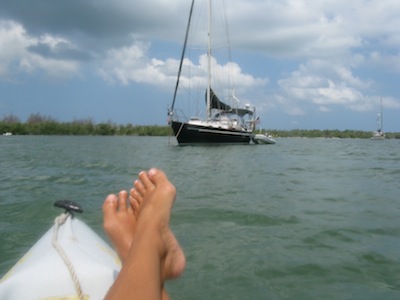
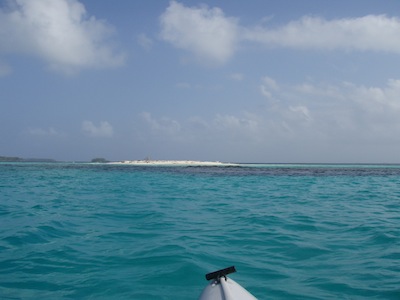










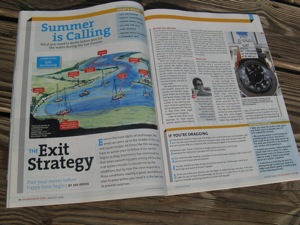


About a year into living on our boat my hubby and I were walking through a sporting goods store looking at the kayaks. We were really concerned about space and based most of our decision on what would comfortable fit on the bow. We ended up with 2 8′ long, 30″ wide sit on tops. That is the trifecta of tippy! It really upped the difficulty level and took some getting used to, We’ve now had them in 2 foot waves and stayed upright but it was a little interesting at first. If I were making the choice now I would probably go a different way, but these things are going to last forever.
We started out with two separate sit on tips and sold them to pay for our sit in tandem. Total turn around but this is definitely the way for us. At least one good thing is that because they’re so sellable, it’s not a lose, lose if you end up changing your mind.
Very true, we get inquiries all the time about selling our kayaks — NO WAY!! We tried a tandem, but couldn’t coordinate our paddling. David in the back thought I (in the front and out of line of sight) should follow his paddle strokes, ugh!) – we quickly decided two separate kayaks were better for us! 🙂
LoL!!
This is the first time I’ve been to your site. Thank you for
providing more details.
Hey Jan…we have an 8′ plastic sit in yak that we can either tow (!) or haul on to the netting of our trimaran. It tows just fine even if we hit 9-10 knots. I prefer the sit in style for stability. Got in among some manatee by accident in FL and gators and felt pretty good/protected in the sit in style (I truly try not to bug the manatee and prefer to keep my distance. I love them!). Awesome in quiet rivers, mangroves, or the cool waters of the North Channel of Georgian Bay as I gunkhole in 6″ of water! Good idea to practice getting back in it if you are not too close to shore. I go over the stern…not pretty but it works.